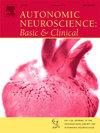自发性高血压大鼠外周血化感受器慢性高氧失活:是否能降低动脉压?
IF 3.3
4区 医学
Q2 NEUROSCIENCES
引用次数: 0
摘要
我们假设,暴露于慢性间歇性高氧的自发性高血压大鼠(SHRs)应该降低在这些动物中观察到的高基线动脉压(高血压)。这项研究的理由是基于SHR中已知的颈动脉化学感受器的过度活动,以及它们对维持交感神经流出和高血压增加的重要贡献。为了验证这一假设,我们将SHR和Wistar Kyoto大鼠(WKY,对照)暴露于间歇性高氧(IH, FIO2在6个周期/小时内从20.8%增加到30%),每天8小时,持续10天。每2天用尾容积描记术评估一次收缩压。实验结束后,在清醒自由活动状态下麻醉大鼠,24h后植入导管进行动脉压记录和药物注射。在IH方案前后通过全身体积描记仪评估呼吸频率,并在方案结束后1天评估心血管和呼吸对外周化学反射激活(KCN)的反应。在气体评估方案结束后一天采集动脉血样本。数据显示,IH对SHR[159±9.02 (N = 4) vs 153±7.85 mmHg (N = 7)]和WKY[115±6.08 (N = 5) vs 111±7.66 (N = 6) mmHg]的平均动脉压与正常对照组相比无显著变化。由于IH对心血管参数没有影响,我们认为IH治疗方案不能有效降低SHR颈动脉体中血管球细胞的过度活性。本文章由计算机程序翻译,如有差异,请以英文原文为准。
Chronic hyperoxic deactivation of peripheral chemoreceptors in spontaneously hypertensive rats: Does it lower arterial pressure?
We hypothetized that spontaneously hypertensive rats (SHRs) exposed to chronic intermittent hyperoxia should reduce the high baseline arterial pressure (hypertension) observed in these animals. The rational for this study was based-upon the known overactivity of carotid chemoreceptors in SHR and their significant contribution to the maintenance of an increased sympathetic outflow and hypertension. To test this hypothesis, we exposed SHR and Wistar Kyoto rats (WKY, control) to intermittent hyperoxia (IH, FIO2 increase from 20.8 to 30 % in 6 cycles/h) 8 h a day during 10 days. Systolic arterial pressure was evaluated every 2 days by tail plethysmography. At the end of the protocols the rats were anesthetized and catheters implanted for arterial pressure recordings and drug injections 24 hs later in the conscious freely moving condition. Respiratory frequency was evaluated by whole body plethysmography before and after the IH protocol and the cardiovascular and respiratory responses to peripheral chemoreflex activation (KCN) were evaluated one day after the end of protocol. Arterial blood samples were collected one day after the end of protocols for gas evaluation. The data shows that IH produced no significant change in mean arterial pressure of SHR [159 ± 9.02 (N = 4) vs 153 ± 7.85 mmHg (N = 7)] or WKY [115 ± 6.08 (N = 5) vs 111 ± 7.66 (N = 6) mmHg)] relative to their respective normoxic control. Since IH produced no changes in the cardiovascular parameters we propose that IH treatment protocol was not effective in reducing the overactivity of glomus cells in the carotid body of SHR.
求助全文
通过发布文献求助,成功后即可免费获取论文全文。
去求助
来源期刊
CiteScore
5.80
自引率
7.40%
发文量
83
审稿时长
66 days
期刊介绍:
This is an international journal with broad coverage of all aspects of the autonomic nervous system in man and animals. The main areas of interest include the innervation of blood vessels and viscera, autonomic ganglia, efferent and afferent autonomic pathways, and autonomic nuclei and pathways in the central nervous system.
The Editors will consider papers that deal with any aspect of the autonomic nervous system, including structure, physiology, pharmacology, biochemistry, development, evolution, ageing, behavioural aspects, integrative role and influence on emotional and physical states of the body. Interdisciplinary studies will be encouraged. Studies dealing with human pathology will be also welcome.

 求助内容:
求助内容: 应助结果提醒方式:
应助结果提醒方式:


